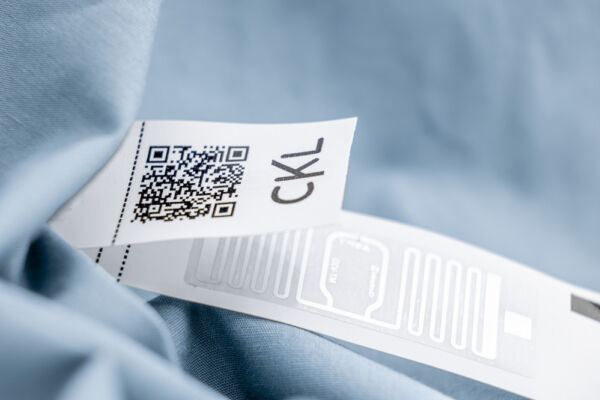Budget sew-in garment labels are about to have their crown snatched by a high-quality, super-durable rival! Upcoming Digital Product Passport legislation means that what used to be a go-to choice might now leave you on the wrong end of the law — especially if your sew-in solutions don’t stand the test of time (or the washing machine). Our Checkpoint Apparel Labeling Solutions crew explain why the change-over to higher-quality labels is happening, how to find the best garment labels, and how to kick off your upgrade project.
Why everyone’s about to upgrade to more durable labels
It's a common conundrum in the fashion industry — do you conserve budget and go for the lower-quality labels or pay out for the long-lasting premium ones? And, until now, it didn't necessarily matter for many brands if they opted for the former. Sure, it wasn't ideal if a label got ratty or faded after a year or two of wear, but it was a compromise that could be made. However, DPP legislation is about to change all that.
Digital Product Passport (DPP) legislation falls under the European Green Deal and is expected to come into force in 2027. It states that all individual items sold into the European market must have a Digital Product Passport that gives customers access to sustainability info about that item until the end of the garment's life.
Read: What is a Digital Product Passport?
The introduction of DPP standards means that garment and apparel labels (A.K.A the DPP ‘data carrier’ that a customer scans to access the cloud-based digital info) must be legible, scannable, and intact for a decade or more. We're entering the age of the high-quality label as standard. If you want to invest wisely, there are a few considerations you'll need to make.

Finding the best clothes labels (according to experts)
Choosing your materials
Your first port of call when looking for better durability is the materials your labels are made from. Ideally, you’ll want to strike a balance between quality and sustainability, especially since your garment labels count towards your environmental impact, which is a huge part of the legislation.
Our experts recommend designing for sustainability, which means prioritizing materials that match the garment for easy recycling or choosing responsible materials. Recycled polyester is a popular go-to where quality, sustainability, and durability are concerned, but cotton and TENCEL are also care-label favorites.
However, the path here isn’t always clear-cut — we recommend working with an expert team with a global supply chain who can advise on the best materials for your budget, use case, branding, and sustainability goals. For example, our Checkpoint crew uses their Planit Process, which is how we help retailers develop more sustainable alternatives to their branded items and packaging.
Wash testing
Our next tip is to make sure your labels are wash-tested to a standard you're happy with because no one wants the scannable bit to fade away after a few hot cycles! For example, our new WashEndure labels are wash-tested to survive a minimum of 100 washes, but tests actually show that they go way beyond that. Callback to the section above — WashEndure labels hit the durability use case but are made using PET, so don't have fabulous sustainability creds. Like we said…it's a process.
Additional upgrades
Do you have the budget to beef up your sew-ins and make them work even harder for you? If so, consider embedding RFID inlays into your labels. This handy retail tech collects valuable real-time data and gives up to 99 percent inventory accuracy.
You'll be able to monitor your carbon footprint, make more sustainable choices, move stock faster, and even have the option to combine your RFID insights with your DPP digital platform (if you're a Checkpoint customer using our CheckLINQ platform, that is). It's a future-proof choice that has been known to deliver super-fast ROI. The option's there…just sayin'!

Globally consistent
This may sound dramatic, but inconsistent garment label production can damage your brand. Incorrect color matches or slight differences in quality can mark you as a brand without good attention to detail and might even make authentic products look like fakes. The black market is getting incredibly good at making knockoffs, and loyal customers are on high alert.
Working with a global labeling partner like us guarantees consistent colors and quality, no matter where in the world your labels are made. It's one of our specialties, in fact! You could also use a specific label material as an anti-counterfeit measure, but this tactic only works if your labels are globally consistent. Something to think about!
Read: Color-matching apparel labels
Planning your label upgrade
Upgrading to durable labels across your whole line can feel incredibly daunting. Especially if you're doing it on top of a DPP rollout. Our best advice is to research and partner with Digital Product Passport companies with label expertise and a proven track record of data-led innovation (hey 👋).
Here at Checkpoint, we're a CIRPASS-2 member and have a seat at the table for all discussions around DPP regulations. And we're not just chatting about it— we're also innovating with the knowledge we gain. We've developed a selection of heavily stress-tested DPP-compliant carrier label options and even have our own fully scalable DPP platform, tested and piloted with a global retail client.
Long story short, when it comes to super high-quality, durable DPP carrier labels and rock-solid DPP rollout plans, the team at Checkpoint has your back. And we're happy to share our knowledge or answer your questions — contact our team today and find out how we can help you. Every client is different, and no two projects are alike, so we've done and seen it all and are happy to share what we've learned.
